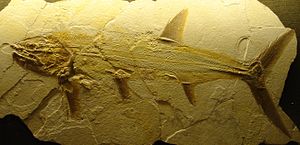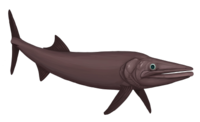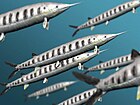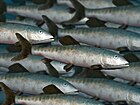Pachycormiformes
| Pachycormiformes Temporal range: Early Jurassic - Late Cretaceous,
| |
|---|---|

| |
| Skeleton of Pachycormus | |

| |
| Skeleton of Orthocormus | |
| Scientific classification | |
| Kingdom: | Animalia |
| Phylum: | Chordata |
| Class: | Actinopterygii |
| Order: | †Pachycormiformes Berg 1937 |
| Family: | †Pachycormidae Woodward, 1895 |
| Type genus | |
| Pachycormus Agassiz, 1833
| |
| Genera | |
|
See text | |
Pachycormiformes is an extinct order of marine ray-finned fish known from the Early Jurassic to the end of the Cretaceous. It only includes a single family, Pachycormidae. They were characterized by having serrated pectoral fins (though more recent studies demonstrated that fin shape diversity in this group was high[1]), reduced pelvic fins and a bony rostrum. Their exact relations with other fish are unclear, but they are generally considered to be teleosteomorphs, more closely related to teleosts than to Holostei. Pachycormiformes are morphologically diverse, containing both tuna and swordfish-like carnivorous forms, as well as edentulous suspension-feeding forms, with the latter including the largest ray finned fish known to have existed, Leedsichthys, with an estimated maximum length of 16 metres.
Synapomorphies
Pachycormiformes are united by "a compound bone (rostrodermethmoid) forming the anterodorsal border of the mouth; a reduced coronoid process of the mandible; absence of supraorbitals associated with a dermosphenotic defining the dorsal margin of the orbit; two large, plate-like suborbital bones posterior to the infraorbitals; long, slender pectoral fins; asymmetrical branching of pectoral fin lepidotrichia; considerable overlap of the hypurals by caudal fin rays (hypurostegy); and the presence of distinctive uroneural-like ossifications of the caudal fin endoskeleton"[2]
Relationships
Pachycormiformes are generally interpreted as members of Teleosteomorpha, the group that includes all fish more closely related to modern teleosts than to Holostei (the group containing bowfin and gars), often they have been considered to be the sister group of the Aspidorhynchiformes.[3]
Gallery
Reconstruction of Protosphyraena perniciosa
Life restoration of Leedsichthys
Life restoration of Ohmdenia
Life restoration of Bonnerichthys
Taxonomy
- Order †Pachycormiformes Berg 1937 [Pachycormida][4][5][6]
- Family †Pachycormidae Woodward 1895 [Protosphyraenidae Cope 1875; Erisichtheidae Cope 1877; Pelecopteridae Cope 1875; Saurostomini Bonaparte 1846 corrig. Bonaparte 1850a; Sauropsidae Cope 1877a; Microlepidoti Zittel 1887] Taxonomy according to[7]
- Genus †Euthynotus Wagner, 1860 [Heterothrissops le Sauvage 1875; Pseudothrissops Sauvage 1875]
- Genus †Haasichthys Delsate, 1999
- Genus †Hypsocormus Wagner, 1860
- Genus †Kaykay Gouiric-Cavalli & Arratia, 2022[8]
- Genus †Notodectes Dolgopol de Saez, 1949
- Genus †Ohmdenia Hauff, 1953
- Genus †Pachycormus Agassiz, 1833 non Coville ex Standley 1923 [?Pachylepis Quenstedt 1858 non Pander 1856; ?Lycodus Quenstedt 1856]
- Genus †Pseudoasthenocormus
- Genus †Sauropsis Agassiz, 1843
- Genus †Saurostomus Agassiz, 1843
- Genus †Simocormus Maxwell et al., 2020
- Macrocarnivore clade
- Genus †Australopachycormus Kear, 2007
- Genus †Orthocormus Weitzel, 1930
- Genus †Protosphyraena Leidy, 1857 [Erisichthe Cope 1872; Pelecopterus Cope 1875]
- Suspension feeding clade
- Genus †Asthenocormus Woodward, 1895 [Agassizia Vetter 1881 non Agassiz & Desor 1847 non Behr 1870 non Yoshiyasu 1987]
- Genus †Bonnerichthys Friedman et al., 2010
- Genus †Leedsichthys Woodward, 1889 [Leedsia Woodward 1890]
- Genus †Martillichthys Liston, 2008
- Genus †Rhinconichthys Friedman et al., 2010
- Family †Pachycormidae Woodward 1895 [Protosphyraenidae Cope 1875; Erisichtheidae Cope 1877; Pelecopteridae Cope 1875; Saurostomini Bonaparte 1846 corrig. Bonaparte 1850a; Sauropsidae Cope 1877a; Microlepidoti Zittel 1887] Taxonomy according to[7]
Cladistics according to Friedman et al. (2010).[9]
| Pachycormiformes |
| ||||||||||||||||||||||||||||||||||||||||||||||||||||||||||||||||||
Sources/external links
- http://www.courtenaymuseum.ca/paleo/paleo/pachycor.html
- https://web.archive.org/web/20081025044133/http://www.palaeos.com/Vertebrates/Units/100Neopterygii/100.600.html
- Sepkoski, Jack (2002). "A compendium of fossil marine animal genera". Bulletins of American Paleontology. 363: 1–560. Retrieved 2011-05-17.
- "Pachycormiformes". Paleobiology Database. Retrieved November 11, 2012.
References
- ^ Liston, Jeff J.; Maltese, Anthony E.; Lambers, Paul H.; Delsate, Dominique; Harcourt-Smith, William E. H.; Heteren, Anneke H. van (2019-11-07). "Scythes, sickles and other blades: defining the diversity of pectoral fin morphotypes in Pachycormiformes". PeerJ. 7: e7675. doi:10.7717/peerj.7675. ISSN 2167-8359. PMC 6842561. PMID 31720097.
- ^ Dobson, Claire; Giles, Sam; Johanson, Zerina; Liston, Jeff; Friedman, Matt (2019-09-03). "Cranial osteology of the Middle Jurassic (Callovian) Martillichthys renwickae (Neopterygii, Pachycormiformes) with comments on the evolution and ecology of edentulous pachycormiforms". Papers in Palaeontology. 7: 111–136. doi:10.1002/spp2.1276. hdl:2027.42/167090. ISSN 2056-2802. S2CID 202919395.
- ^ Peskin, Brianna; Henke, Katrin; Cumplido, Nicolás; Treaster, Stephen; Harris, Matthew P.; Bagnat, Michel; Arratia, Gloria (2020-07-20). "Notochordal Signals Establish Phylogenetic Identity of the Teleost Spine". Current Biology. 30 (14): 2805–2814.e3. doi:10.1016/j.cub.2020.05.037. ISSN 0960-9822. PMC 8159021. PMID 32559448.
- ^ Haaramo, Mikko (2007). "†Pachycormiformes". Mikko's Phylogeny Archive. Retrieved 30 December 2016.
- ^ Nelson, Joseph S.; Grande, Terry C.; Wilson, Mark V. H. (2016). Fishes of the World (5th ed.). John Wiley & Sons. ISBN 9781118342336.
- ^ van der Laan, Richard (2016). "Family-group names of fossil fishes".
{{cite journal}}: Cite journal requires|journal=(help) - ^ Wretman, Lovisa; Blom, Henning; Kear, Benjamin P. (2016-09-02). "Resolution of the Early Jurassic actinopterygian fish Pachycormus and a dispersal hypothesis for Pachycormiformes". Journal of Vertebrate Paleontology. 36 (5): e1206022. doi:10.1080/02724634.2016.1206022. ISSN 0272-4634. S2CID 89338085.
- ^ Gouiric-Cavalli, S.; Arratia, G. (2022). "A new †Pachycormiformes (Actinopterygii) from the Upper Jurassic of Gondwana sheds light on the evolutionary history of the group". Journal of Systematic Palaeontology. 19 (21): 1517–1550. doi:10.1080/14772019.2022.2049382. S2CID 248454343.
- ^ Matt Friedman; Kenshu Shimada; Larry D. Martin; Michael J. Everhart; Jeff Liston; Anthony Maltese; Michael Triebold (2010). "100-million-year dynasty of giant planktivorous bony fishes in the Mesozoic seas". Science. 327 (5968): 990–993. Bibcode:2010Sci...327..990F. doi:10.1126/science.1184743. PMID 20167784. S2CID 206524637.
Error: "Q1227671" is not a valid Wikidata entity ID.
- CS1 errors: missing periodical
- Articles with short description
- Articles with 'species' microformats
- Taxonbars desynced from Wikidata
- Taxonbar pages requiring a Wikidata item
- Taxonbars with invalid from parameters
- Taxonbars without secondary Wikidata taxon IDs
- Pachycormiformes
- Late Triassic first appearances
- Maastrichtian extinctions
- Prehistoric ray-finned fish orders










